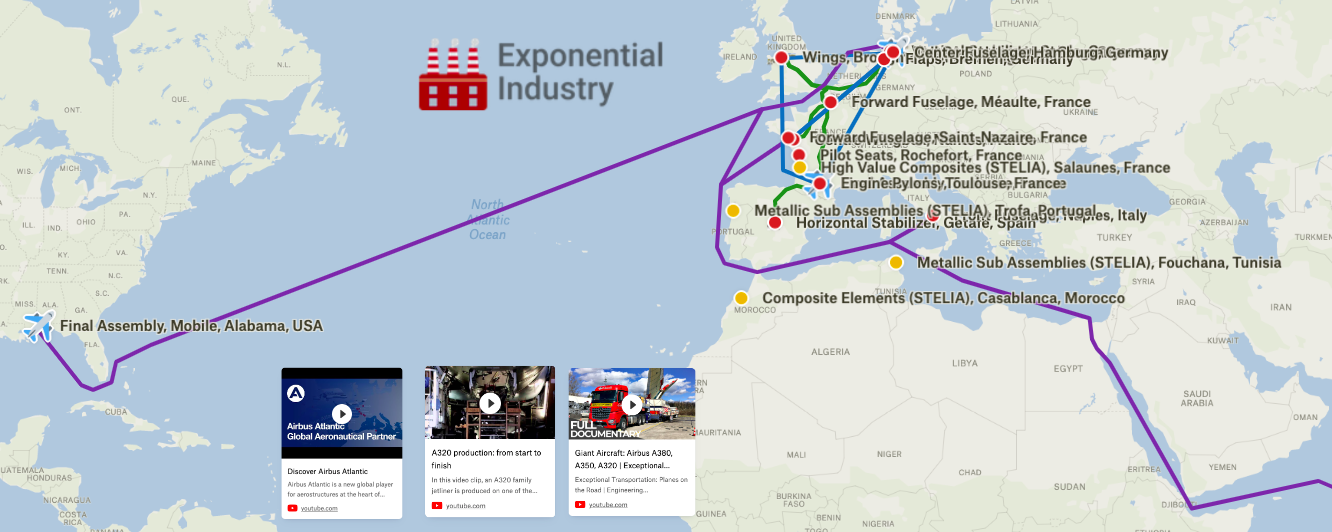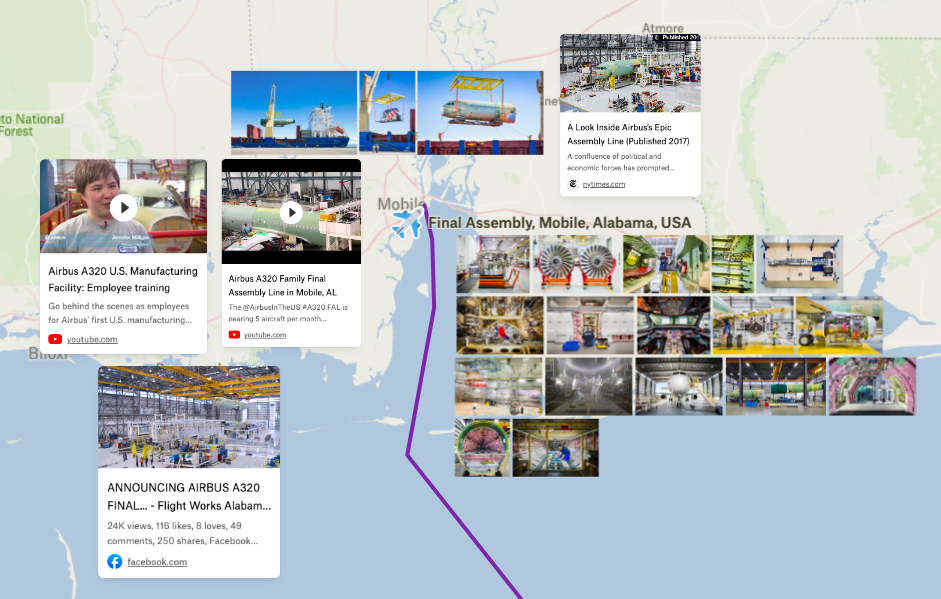Mapped: An Interactive Journey of the Airbus A320 Supply Chain
On the news of a massive new orders for Airbus’ A320neo across China. Exponential Industry has put together an interactive map exploring the supply chain and assembly facilities of the Airbus A320 family of aircraft. The A320 family includes the A319ceo, A319neo, A320ceo, A320neo, A321ceo, and A321neo. The A320 is the currently world’s best-selling commercial jet aircraft.
An interactive map of the Airbus A320, A321, A319 supply chain. Click the image to launch the app.
Zoom into each location to learn more about the setup and assembly of the A320 aircraft.
An interactive map of the Airbus A320 assembly in Mobile, Alabama, USA.
Where is the Airbus A320 built?
The Airbus A320 family of aircraft is assembled throughout Europe with primary operations in Toulouse, France and Hamburg, Germany. Final assembly also occurs at facilities in Mobile, Alabama, USA and Tianjin, China.
How big is the Airbus supply chain?
The Airbus supply chain comprises over 4000 suppliers including all airborne parts and appliance suppliers. The supply chain spans dozens of countries across six continents with suppliers predominately within Europe, North Africa, United States, and China.
Assembly Line
Capturing this week's trending industry 4.0 and emerging industrial technology media
Industry 4.0 at Škoda
Over the past few years, Škoda has invested millions of dollars in state-of-the-art assembly technologies to increase productivity, improve worker safety, and decrease the company’s environmental footprint. As part of an overall Industry 4.0 strategy, the company has implemented additive manufacturing, artificial intelligence, augmented reality, autonomous mobile robots and other technology.
Adding a new workstation to an assembly line requires careful planning—especially if regular operations are expected to continue at the same time. When engineers at Škoda’s assembly plant in Vrchlabí, Czech Republic, wanted to integrate a new robot into a gearbox production line, the project was fully operational in just three weeks—thanks to digital twin technology. Within a cycle time of less than 30 seconds, the new workstation installs bearings into each gearbox. Robots install the bearings to meet the precision requirements of the application.
Optikon uses mathematical combinatorial analysis methods to find various solutions to what is known as the “knapsack problem.” It addresses the question of how certain objects can be optimally fitted into a limited space. While the classic knapsack problem only takes into account the weight and value of the items to be packed, Optikon also considers floor space, the volume of the item, and when the goods have to be shipped.
Renault Group and Atos launch a unique service to collect large-scale manufacturing data and accelerate Industry 4.0
Renault Group and Atos launch ID@scale (Industrial Data @ Scale), a new service for industrial data collection to support manufacturing companies in their digital journey towards Industry 4.0. “ID@S” (Industrial Data @ Scale) will allow manufacturers to collect and structure data from industrial equipment at scale to improve operational excellence and product quality. Developed by the car manufacturer and already in operation within its factories, ID@scale is now industrialized, modularized and commercialized by the digital leader Atos.
More than 7,500 pieces of equipment are connected, with standardized data models representing over 50 different manufacturing processes from screwdriving to aluminum injection, including car frame welding, machining, painting, stamping, in addition to new manufacturing processes for electric motors and batteries. Renault Group is already saving 80 million euros per year and aims to deploy this solution across the remainder of its 35 plants, connecting over 22,000 pieces of equipment, by 2023 to generate savings of 200 million euros per year.
HoloLens 2 helps Novo Nordisk employees see work in new ways
The pharmaceutical giant, a leader in the global production of diabetes medicine, has been pioneering the use of emerging digital technologies for everything from simplifying floor operations in their manufacturing facilities across the globe to conducting virtual site visits from thousands of miles away. Some of those solutions include Microsoft HoloLens 2, Microsoft Dynamics 365 Remote Assist, Microsoft Dynamics 365 Guides and Microsoft Power Platform. This includes introducing what is known as augmented instructions, via HoloLens 2, to shop floor employees, providing them with new possibilities to support both process performance and getting onboarded for new procedures.
Autonomous intralogistics from indoors to outdoors for a safe and seamless logistics chain
AI-Guided Robots Are Ready to Sort Your Recyclables
So how much of the material that goes into the typical bin avoids a trip to landfill? For countries that do curbside recycling, the number—called the recovery rate—appears to average around 70 to 90 percent, though widespread data isn’t available. That doesn’t seem bad. But in some municipalities, it can go as low as 40 percent.
Getting AI into the recycling business means combining pick-and-place robots with accurate real-time object detection. Pick-and-place robots combined with computer vision systems are used in manufacturing to grab particular objects, but they generally are just looking repeatedly for a single item, or for a few items of known shapes and under controlled lighting conditions. Recycling, though, involves infinite variability in the kinds, shapes, and orientations of the objects traveling down the conveyor belt, requiring nearly instantaneous identification along with the quick dispatch of a new trajectory to the robot arm.
How can we help reduce plastic waste? Facilitating the use of recycled plastics using in-mold sensors to optimize the injection molding process
To use recycled materials with material properties that fluctuate from lot-to-lot, conventionally, a skilled operator made fine manual adjustments to the injection molding process conditions according to the material properties. As this is time consuming and requires experience, this has limited the type and amount of recycled materials used as manufacturers have sought to use recycled materials with consistent properties.
To address this issue, my colleagues and I conducted a study where we looked at how we could automatically optimize the process conditions and thereby contribute to quality, and presented our results at the 37th International Conference of the Polymer Processing Society (PPS-37) which was held in Fukuoka, Japan, from 11-15 April 2022. Below, I’d like to briefly share what we did.
Nothing to see here just a cyber attack destroying a steel mill.https://t.co/PxxbeG557L
— joshua steinman (🇺🇸,🇺🇸) (@JoshuaSteinman) June 27, 2022
Improving asset criticality with better decision making at the plant level
The industry is beginning to see reliability, availability and maintainability (RAM) applications that integrally highlight the real constraints, including the other operational and mechanical limits. A RAM-based simulation application provides fault-tree analysis, based on actual material flows through a manufacturing process, with stage gates, inventory modeling, load sharing, standby/redundancy of equipment, operational phases, and duty cycles. In addition, a RAM application can simulate expectations of various random events such as weather, market dynamics, supply/distribution logistical events, and more. In one logistics example, a coker unit’s bottom pump was thought to be undersized and constraining the unit production. Changing the pump to a larger size did not fix the problem, because further investigation showed insufficient trucks on the train to carry the product away would not let the unit operate at full capacity.
A simulation-based approach to design an automated high-mix low-volume manufacturing system
In this paper, we address the profit optimization problem of an automated high-mix low-volume manufacturing system, which originates from a real-world problem at our industry partner. The manufacturing system includes buffer units from which jobs are automatically transported to workstations, i.e., using automated material handling devices. We consider three different automation concepts for the system: (1) a configuration with parallel buffers and a dedicated robot to work them, (2) a configuration that employs shared buffers that are tended to by automated guided vehicles (AGVs), and (3) a proposed hybrid configuration that takes elements of both aforementioned configurations. We propose a simulation-based approach, which uses simulated-annealing (SA), enriched with the reduced variable neighborhood search (RVNS), to determine the best system configuration for a high-mix, low-volume manufacturer. Decisions concern the choice of automation equipment and the capacity of both parallel and shared buffers. We illustrate the efficacy of the proposed hybrid concept and the proposed SA-RVNS approach with an industry case study using real-world data from our industry partner. Our analysis shows that the proposed concept increases the profit by around 10–30% compared to the others, and the AGV travel time plays an important factor in the proposed concept to yield its true potential.
Underground beer line doesn’t let a drop go to waste
Capital Expenditure
Tracking this week's major mergers, partnerships, and funding events in manufacturing and supply chain
The Metaverse Goes Industrial: Siemens, NVIDIA Extend Partnership to Bring Digital Twins Within Easy Reach
Silicon Valley magic met Wednesday with 175 years of industrial technology leadership as Siemens CEO Roland Busch and NVIDIA Founder and CEO Jensen Huang shared their vision for an “industrial metaverse” at the launch of the Siemens Xcelerator business platform in Munich. Pairing physics-based digital models from Siemens with real-time AI from NVIDIA, the companies announced they will connect the Siemens Xcelerator and NVIDIA Omniverse platforms.
The partnership also promises to make factories more efficient and sustainable. Users will more easily be able to turn data streaming from the factory floor PLCs and sensors into AI models. These models can be used to continuously optimize performance, predict problems, reduce energy consumption, and streamline the flow of parts and materials across the factory floor.
Siemens acquires Brightly Software to accelerate growth in digital building operations
Siemens Smart Infrastructure (SI), the frontrunner in digital buildings, has signed an agreement to acquire Brightly Software, a leading U.S.-based software-as-a-service (SaaS) provider of asset and maintenance management solutions. The acquisition elevates SI to a leading position in the software market for buildings and built infrastructure. The purchase price is USD 1.575 billion, plus an earn-out. The acquisition will add Brightly’s well-established cloud-based capabilities across key sectors – education, public infrastructure, healthcare, and manufacturing – to Siemens’ digital and software know-how in buildings.
Surge Demand
Additional news stories across the global industrial environment
A look inside the difficulties with Boeing’s 787. Samsung jumps ahead in the race for 3nm chip production.


